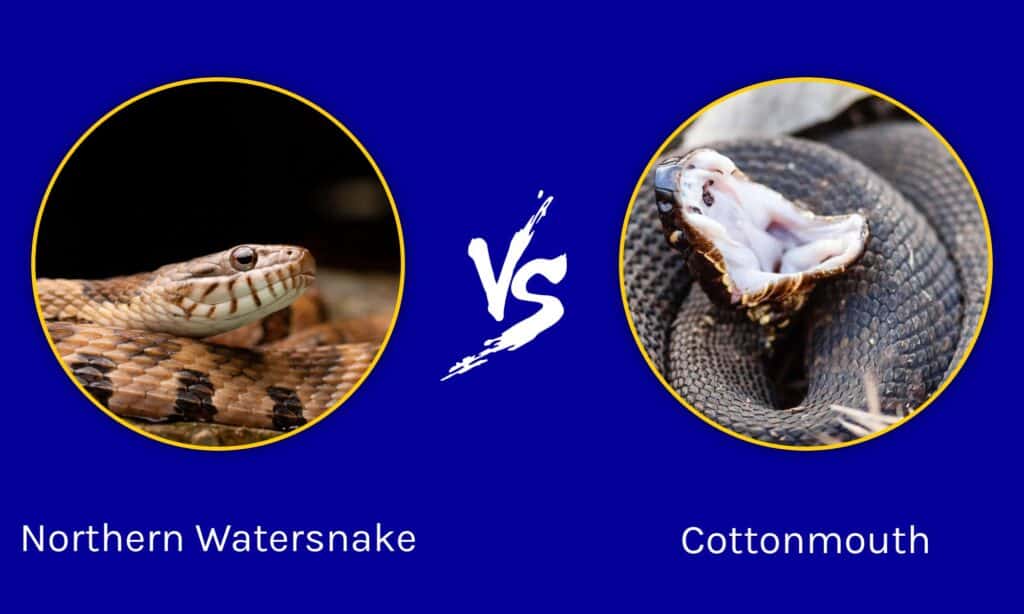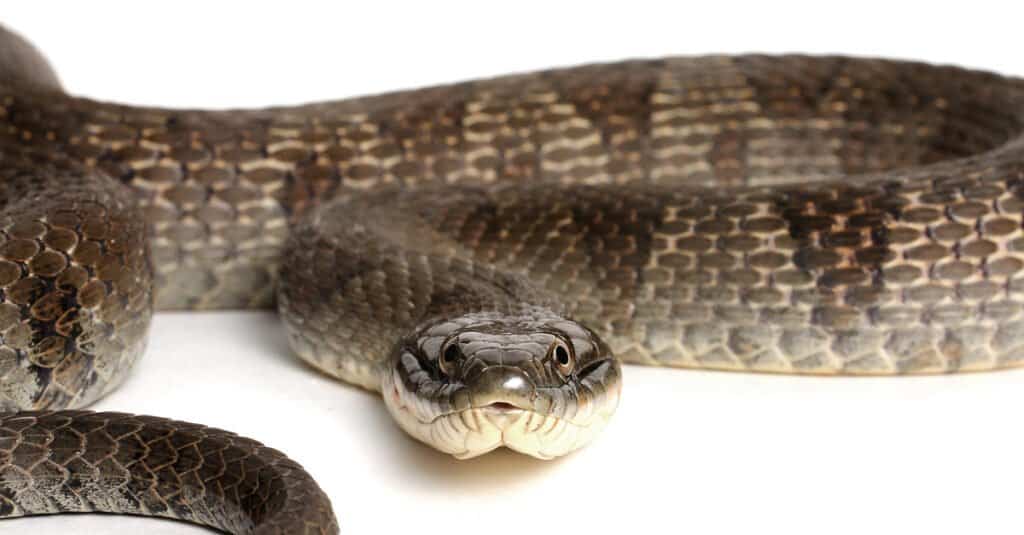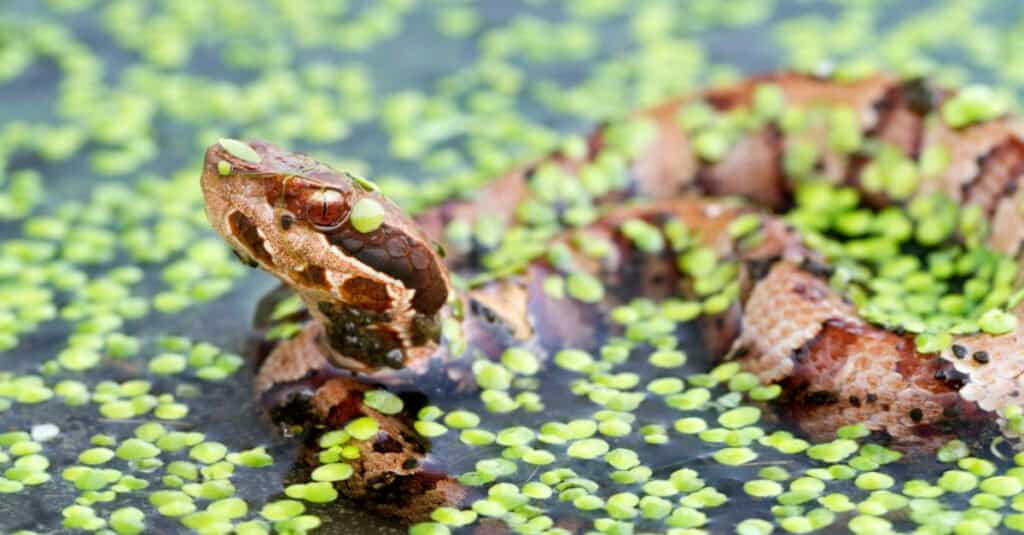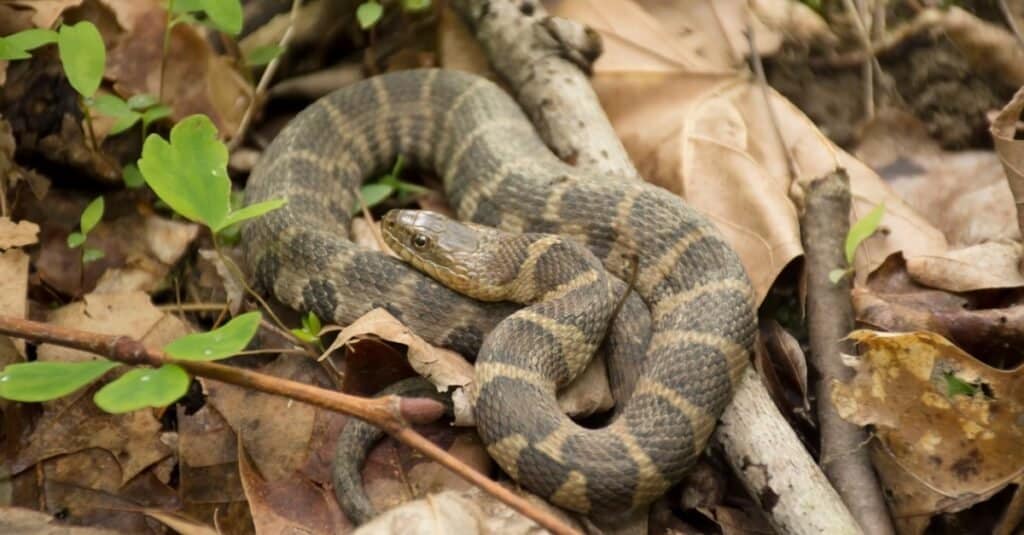Snakes live on almost every continent on earth, except Antarctica. Some are so deadly that a single bite can kill a human, while others are so benign that they couldn’t hurt us if they tried. North America is no exception when it comes to snakes; the United States contains no less than 100 distinct snake species, some of which can be deadly. In the eastern half of the country, there are two species that look similar — especially if you’re unfamiliar with snakes. These are the northern watersnake and the cottonmouth, also known as the water moccasin.
Both cottonmouths and northern watersnakes are semi-aquatic reptiles. Like all snakes, they rely on the sun to warm their bodies; both species hide away in unused holes or burrows if it gets too cold out. They may share many similarities, but only one of these species is venomous.
Here, we’ll discuss the ways you can tell the difference between a northern watersnake and a water moccasin. We’ll start by taking a look at their appearances, individual habitats, and behaviors. Then, we’ll explore each species’ diet and hunting methods. Finally, we’ll go over which snake has a deadly bite, and what you should do if either species sinks its teeth into you.
The Key Differences Between a Northern Watersnake and a Cottonmouth

The primary difference between a northern watersnake and a cottonmouth is that northern watersnakes are nonvenomous. Both snakes can bite and the northern watersnake’s bite can be quite painful. However, their bite does not bring the same potentially dire consequences if not treated. In addition, the two snakes have vastly different diets and differences in appearance. Let’s dive into the key differences between these snakes one by one.
Northern Watersnake Vs Cottonmouth: Appearance
Both the northern watersnake (Nerodia sipedon sipedon) and the cottonmouth (Agkistrodon piscivorus) grow to about 4.5 feet in length. They’re both heavy-bodied snakes, unlike the graceful black racer snake. And, each species presents in yellow-brown to brown-gray colors, though adult cottonmouths tend to be darker.
Perhaps the easiest difference to spot between the two, at first glance, is their patterning. Water moccasins have distinct bands of darker scales, while northern watersnakes have squarish splotches, rather than bands. Further, as pit vipers, cottonmouths have visible ‘pits’ between their eyes and nostrils which northern watersnakes lack.

Northern water snakes tend to be lighter in color than cottonmouths
©iStock.com/Doug Gordon
If you’re lucky enough to see a water moccasin up close without getting bitten, you’ll notice that the inside of its mouth is a bright, cotton-white color. Cottonmouths get their name from this coloration; they open their mouths as a defensive gesture, and a warning that they will bite if you get any closer. Northern watersnakes, in contrast, have no such coloring inside their mouths.
Northern Watersnake Vs Cottonmouth: Habitat

Northern watersnakes don’t have the same white coloring on the inside of their mouths that cottonmouths have.
©Michiel de Wit/Shutterstock.com
Where northern watersnakes can be found as far north as the shores of the Great Lakes, cottonmouths only occur as far north as Virginia. The two species do have some overlap in range but are mostly constricted to separate areas. Water moccasins are common throughout Florida, Georgia, and the southeastern coastal areas of the United States, while northern watersnakes occur inland, and aren’t found in Florida.
As far as local habitat goes, both the water moccasin and the northern watersnake prefer living in or around sources of permanent or semi-permanent water. They’re semi-aquatic species, and both are exceptional swimmers. They’re generally found near lakes, rivers, floodplains, ponds, or marshes. Both the northern watersnake and the cottonmouth can often be seen draped over branches overhanging water, or soaking up the sun on rocks near the water’s edge.
Northern Watersnake Vs Cottonmouth: Behavior
If you want to see the egg of a northern watersnake, or a cottonmouth, you’re out of luck. Females of both species actually incubate their eggs inside their bodies. The eggs hatch inside too, leaving the females to give birth to live young in the summer and early fall. As they grow, northern watersnakes learn to flee to the water when predators come around, while baby cottonmouths learn how to stand their ground.

Cottonmouths have elliptical pupils, while northern watersnakes have round pupils
©Mark_Kostich/Shutterstock.com
Neither species can really be called aggressive, but, like all wild animals, both will act to defend themselves if necessary. When it comes to humans, this is most evident in cases of accidental, or purposeful, contact. When threatened, water moccasins actually coil into a ball and open their mouths wide, showing off their white cheeks to ward off predators.
Northern Watersnake Vs Cottonmouth: Diet
They may look similar, but northern watersnakes and cottonmouths have vastly different diets. Northern watersnakes do most of their hunting in the water, and eat primarily fish and amphibians like toads, frogs, and salamanders. Water moccasins also eat fish and frogs, but they’ll also make a meal of turtles, baby alligators, birds, rodents, and other snakes.
Both species utilize ambush hunting—lying in wait for some unlucky creature to get too close. But, they’ve also been observed actively hunting, moving about in search of prey.
Northern Watersnake Vs Cottonmouth: Venom
Cottonmouths come with venom, but northern watersnakes are, for humans at least, harmless. As a member of the pit viper family—along with rattlesnakes and copperheads—the water moccasin has two venom glands, and two large fangs to match. Cottonmouths use their venom in a quick strike to the prey’s body. Then, they wait for the creature to die, then swallow it whole.

Northern watersnakes may look like cottonmouths, but they’re non-venomous
©iStock.com/IcemanJ
Like other pit vipers, water moccasins have hemotoxic venom that acts on the victim’s nervous system and the tissue surrounding the bite. Cottonmouth venom causes necrotization of the flesh, meaning that the flesh around the bite actually starts to die.
Northern Watersnake Vs Cottonmouth: Which is More Dangerous?
While you should never attempt to handle either the northern watersnake or the cottonmouth, only the cottonmouth presents a serious threat. Northern watersnakes aren’t venomous, though they can inflict painful bites. Water moccasins, on the other hand, can envenomate people. Left untreated, their venom can cause serious complications, and rarely, death.
If you are bitten by a cottonmouth, or a snake you think might be a cottonmouth, seek immediate medical attention. Do not attempt to kill or capture the snake to show to medical personnel. The faster you receive medical treatment for your bite, the less your chances of serious complications from the venom.
Which State Is the Most Snake-Infested in the U.S.?

The subject of snakes strikes fear in the hearts of many a U.S. citizen, unfortunately. While snakes serve a valuable purpose in the wild of keeping rodent populations in check, many people don’t appreciate that fact. Regardless, the subject begs the question–which U.S. states are the most snake-infested?
The state that ranks number one for the most snakes is Texas, with a whopping 68 snake species! Venomous snakes in the state are several rattlesnake species, copperheads, cottonmouths, and Texas coral snakes. Nonvenomous snakes include the Texas indigo, Texas brown snake, Texas blind snake, and one of the most numerous–the Texas rat snake. The greatest concentration of snakes is in central Texas.
The top 10 most snake-infested states are as follows:
- Texas — 68 species
- Arizona — 52 species
- Nevada — 52 species
- California — 49 species
- Louisiana — 48 species
- Missouri — 47 species
- New Mexico — 46 species
- Oklahoma — 46 species
- Georgia — 46 species
- Florida — 44 species
- Alabama — 43 species
The photo featured at the top of this post is © Michiel de Wit/Shutterstock.com
Discover the "Monster" Snake 5X Bigger than an Anaconda
Every day A-Z Animals sends out some of the most incredible facts in the world from our free newsletter. Want to discover the 10 most beautiful snakes in the world, a "snake island" where you're never more than 3 feet from danger, or a "monster" snake 5X larger than an anaconda? Then sign up right now and you'll start receiving our daily newsletter absolutely free.
Thank you for reading! Have some feedback for us? Contact the AZ Animals editorial team.






